Exploring Appropriate Preprocessing Techniques for Hyperspectral Soil Organic Matter Content Estimation in Black Soil Area
Abstract
:1. Introduction
2. Materials and Methods
2.1. Study Area
2.2. Sample Collection and Statistics
2.3. Spectral Measurement
2.4. Preprocessing Methods
3. Results
3.1. Correlation Analysis Between SOM Content and Reflectance Data
3.2. Accuracy Analysis of SOM Content Estimation Models
3.2.1. Comparison of Modeling Results for Denoising Methods
3.2.2. Comparison of Modeling Results for Fractional Derivatives of Different Orders
3.2.3. Comparison of Modeling Results for Dimensionality Reduction Methods
4. Discussion
4.1. Denoising Methods for SOM Content Estimation in Black Soil Area
4.2. Fractional Derivatives for SOM Content Estimation in Black Soil Area
4.3. Dimensionality Reduction Methods for SOM Content Estimation in Black Soil Area
5. Conclusions
Author Contributions
Funding
Acknowledgments
Conflicts of Interest
Appendix A
Appendix A.1. Denoising Methods
Appendix A.2. Fractional Derivative
Appendix A.3. Dimensionality Reduction Methods
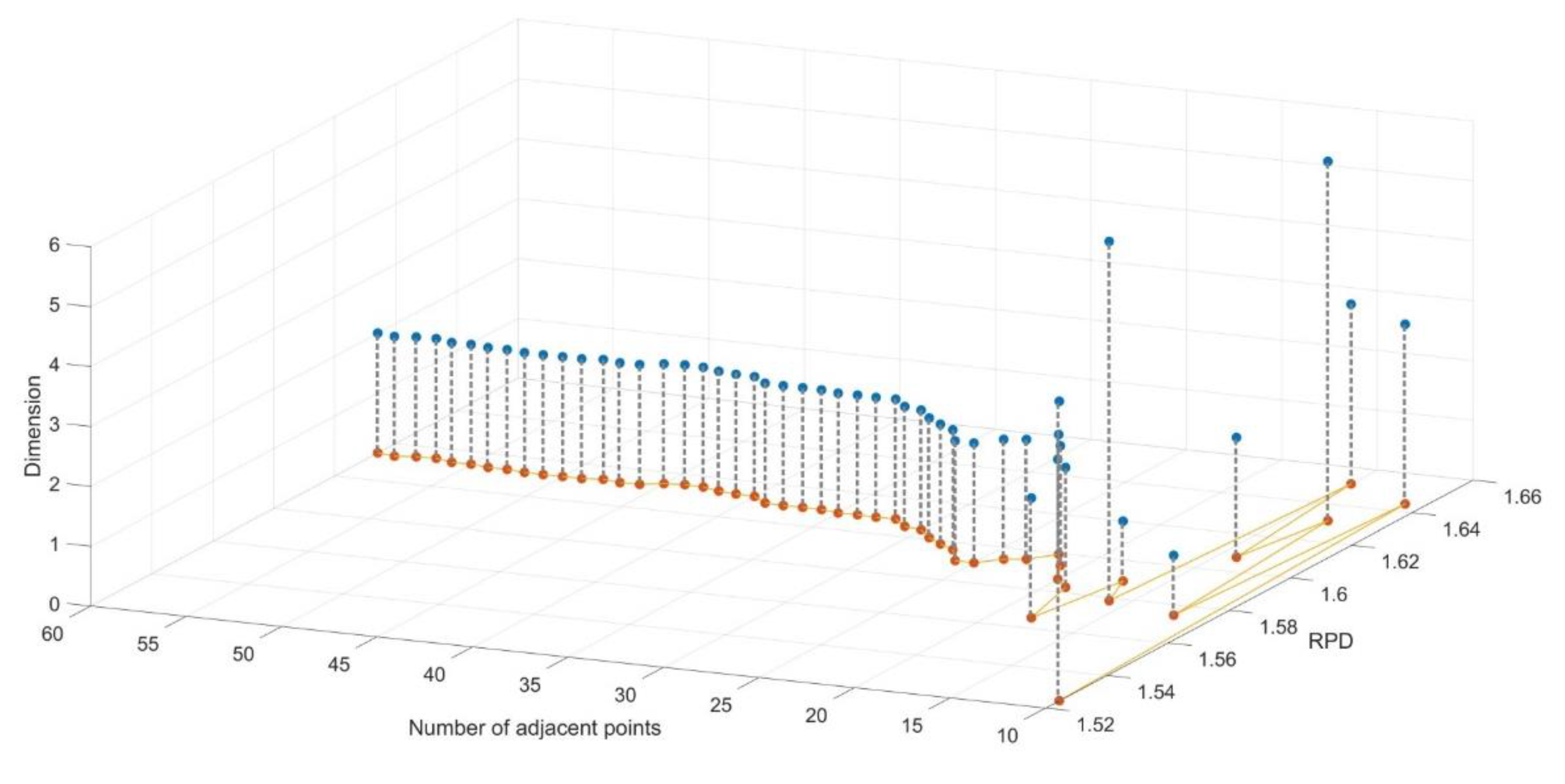
Appendix A.4. Partial Least Squares Regression (PLSR)
Appendix B
| Denoising Methods | Order | R2 | RMSE | RPD | Denoising Methods | Order | R2 | RMSE | RPD |
|---|---|---|---|---|---|---|---|---|---|
| MSC | 0 | 0.61 | 0.40 | 1.60 | SGF | 0 | 0.80 | 0.29 | 2.23 |
| 0.2 | 0.78 | 0.31 | 2.08 | 0.2 | 0.80 | 0.29 | 2.22 | ||
| 0.4 | 0.77 | 0.32 | 2.02 | 0.4 | 0.83 | 0.26 | 2.47 | ||
| 0.6 | 0.78 | 0.32 | 1.99 | 0.6 | 0.85 | 0.25 | 2.60 | ||
| 0.8 | 0.75 | 0.33 | 1.92 | 0.8 | 0.79 | 0.29 | 2.18 | ||
| 1 | 0.64 | 0.42 | 1.54 | 1 | 0.76 | 0.31 | 2.07 | ||
| 1.2 | 0.59 | 0.45 | 1.44 | 1.2 | 0.76 | 0.32 | 2.04 | ||
| 1.4 | 0.56 | 0.43 | 1.50 | 1.4 | 0.75 | 0.32 | 2.00 | ||
| 1.6 | 0.55 | 0.43 | 1.49 | 1.6 | 0.75 | 0.32 | 2.00 | ||
| 1.8 | 0.51 | 0.47 | 1.36 | 1.8 | 0.71 | 0.34 | 1.86 | ||
| 2 | 0.31 | 0.53 | 1.21 | 2 | 0.54 | 0.44 | 1.47 | ||
| WPT | 0 | 0.72 | 0.35 | 1.83 | N | 0 | 0.65 | 0.39 | 1.66 |
| 0.2 | 0.77 | 0.32 | 2.00 | 0.2 | 0.77 | 0.32 | 2.00 | ||
| 0.4 | 0.76 | 0.33 | 1.92 | 0.4 | 0.78 | 0.33 | 1.96 | ||
| 0.6 | 0.79 | 0.32 | 2.02 | 0.6 | 0.80 | 0.32 | 2.03 | ||
| 0.8 | 0.77 | 0.34 | 1.91 | 0.8 | 0.76 | 0.32 | 1.98 | ||
| 1 | 0.73 | 0.35 | 1.82 | 1 | 0.68 | 0.40 | 1.62 | ||
| 1.2 | 0.67 | 0.37 | 1.73 | 1.2 | 0.62 | 0.40 | 1.60 | ||
| 1.4 | 0.63 | 0.40 | 1.61 | 1.4 | 0.57 | 0.43 | 1.48 | ||
| 1.6 | 0.59 | 0.41 | 1.56 | 1.6 | 0.54 | 0.45 | 1.42 | ||
| 1.8 | 0.52 | 0.45 | 1.44 | 1.8 | 0.40 | 0.50 | 1.29 | ||
| 2 | 0.36 | 0.51 | 1.25 | 2 | 0.31 | 0.53 | 1.21 |
| Denoising Methods | Order | R2 | RMSE | RPD | Denoising Methods | Order | R2 | RMSE | RPD |
|---|---|---|---|---|---|---|---|---|---|
| MSC | 0 | 0.56 | 0.42 | 1.51 | SGF | 0 | 0.80 | 0.29 | 2.24 |
| 0.2 | 0.58 | 0.42 | 1.53 | 0.2 | 0.80 | 0.29 | 2.23 | ||
| 0.4 | 0.57 | 0.42 | 1.52 | 0.4 | 0.80 | 0.28 | 2.26 | ||
| 0.6 | 0.58 | 0.42 | 1.54 | 0.6 | 0.84 | 0.26 | 2.48 | ||
| 0.8 | 0.59 | 0.41 | 1.55 | 0.8 | 0.80 | 0.29 | 2.22 | ||
| 1 | 0.53 | 0.44 | 1.47 | 1 | 0.64 | 0.39 | 1.66 | ||
| 1.2 | 0.36 | 0.51 | 1.26 | 1.2 | 0.18 | 0.58 | 1.10 | ||
| 1.4 | 0.36 | 0.51 | 1.25 | 1.4 | 0.15 | 0.59 | 1.09 | ||
| 1.6 | 0.12 | 0.60 | 1.07 | 1.6 | 0.14 | 0.60 | 1.08 | ||
| 1.8 | 0.05 | 0.62 | 1.03 | 1.8 | 0.06 | 0.62 | 1.04 | ||
| 2 | 0.08 | 0.62 | 1.04 | 2 | 0.08 | 0.70 | 0.92 | ||
| WPT | 0 | 0.65 | 0.38 | 1.68 | N | 0 | 0.57 | 0.42 | 1.53 |
| 0.2 | 0.63 | 0.39 | 1.65 | 0.2 | 0.65 | 0.38 | 1.69 | ||
| 0.4 | 0.63 | 0.39 | 1.65 | 0.4 | 0.63 | 0.39 | 1.65 | ||
| 0.6 | 0.65 | 0.38 | 1.70 | 0.6 | 0.66 | 0.38 | 1.71 | ||
| 0.8 | 0.65 | 0.38 | 1.68 | 0.8 | 0.66 | 0.38 | 1.68 | ||
| 1 | 0.56 | 0.43 | 1.51 | 1 | 0.50 | 0.45 | 1.42 | ||
| 1.2 | 0.32 | 0.53 | 1.21 | 1.2 | 0.26 | 0.55 | 1.17 | ||
| 1.4 | 0.33 | 0.53 | 1.22 | 1.4 | 0.28 | 0.54 | 1.18 | ||
| 1.6 | 0.20 | 0.58 | 1.11 | 1.6 | 0.12 | 0.61 | 1.05 | ||
| 1.8 | 0.06 | 0.62 | 1.03 | 1.8 | 0.07 | 0.62 | 1.04 | ||
| 2 | 0.08 | 0.62 | 1.04 | 2 | 0.07 | 0.62 | 1.03 |
| Denoising Methods | Order | R2 | RMSE | RPD | Denoising Methods | Order | R2 | RMSE | RPD |
|---|---|---|---|---|---|---|---|---|---|
| MSC | 0 | 0.64 | 0.38 | 1.67 | SGF | 0 | 0.74 | 0.36 | 1.78 |
| 0.2 | 0.60 | 0.41 | 1.56 | 0.2 | 0.73 | 0.37 | 1.75 | ||
| 0.4 | 0.62 | 0.40 | 1.61 | 0.4 | 0.73 | 0.37 | 1.75 | ||
| 0.6 | 0.66 | 0.38 | 1.70 | 0.6 | 0.77 | 0.34 | 1.87 | ||
| 0.8 | 0.60 | 0.41 | 1.58 | 0.8 | 0.83 | 0.27 | 2.39 | ||
| 1 | 0.62 | 0.40 | 1.61 | 1 | 0.83 | 0.27 | 2.41 | ||
| 1.2 | 0.55 | 0.43 | 1.49 | 1.2 | 0.82 | 0.28 | 2.32 | ||
| 1.4 | 0.41 | 0.49 | 1.30 | 1.4 | 0.80 | 0.30 | 2.11 | ||
| 1.6 | 0.34 | 0.52 | 1.24 | 1.6 | 0.78 | 0.31 | 2.09 | ||
| 1.8 | 0.23 | 0.56 | 1.14 | 1.8 | 0.73 | 0.33 | 1.94 | ||
| 2 | 0.14 | 0.59 | 1.08 | 2 | 0.56 | 0.43 | 1.51 | ||
| WPT | 0 | 0.63 | 0.39 | 1.65 | N | 0 | 0.63 | 0.39 | 1.65 |
| 0.2 | 0.61 | 0.41 | 1.58 | 0.2 | 0.61 | 0.40 | 1.60 | ||
| 0.4 | 0.61 | 0.40 | 1.60 | 0.4 | 0.62 | 0.40 | 1.61 | ||
| 0.6 | 0.62 | 0.40 | 1.62 | 0.6 | 0.64 | 0.39 | 1.66 | ||
| 0.8 | 0.66 | 0.38 | 1.70 | 0.8 | 0.58 | 0.41 | 1.55 | ||
| 1 | 0.66 | 0.38 | 1.71 | 1 | 0.62 | 0.39 | 1.63 | ||
| 1.2 | 0.54 | 0.44 | 1.47 | 1.2 | 0.40 | 0.49 | 1.30 | ||
| 1.4 | 0.38 | 0.50 | 1.27 | 1.4 | 0.25 | 0.56 | 1.16 | ||
| 1.6 | 0.27 | 0.55 | 1.17 | 1.6 | 0.18 | 0.58 | 1.11 | ||
| 1.8 | 0.15 | 0.59 | 1.09 | 1.8 | 0.17 | 0.58 | 1.10 | ||
| 2 | 0.11 | 0.61 | 1.05 | 2 | 0.12 | 0.61 | 1.06 |
References
- Zeraatpisheh, M.; Bakhshandeh, E.; Hosseini, M.; Alavi, S.M. Assessing the effects of deforestation and intensive agriculture on the soil quality through digital soil mapping. Geoderma 2020, 363, 114139. [Google Scholar] [CrossRef]
- Abdalla, M.; Hastings, A.; Chadwick, D.; Jones, D.; Evans, C.; Jones, M.B.; Rees, R.; Smith, P. Critical review of the impacts of grazing intensity on soil organic carbon storage and other soil quality indicators in extensively managed grasslands. Agric. Ecosyst. Environ. 2018, 253, 62–81. [Google Scholar] [CrossRef] [PubMed] [Green Version]
- Schillaci, C.; Acutis, M.; Lombardo, L.; Lipani, A.; Fantappie, M.; Märker, M.; Saia, S. Spatio-temporal topsoil organic carbon mapping of a semi-arid Mediterranean region: The role of land use, soil texture, topographic indices and the influence of remote sensing data to modelling. Sci. Total Environ. 2017, 601, 821–832. [Google Scholar] [CrossRef] [PubMed]
- Aldana-Jague, E.; Heckrath, G.; Macdonald, A.; van Wesemael, B.; Van Oost, K. UAS-based soil carbon mapping using VIS-NIR (480–1000 nm) multi-spectral imaging: Potential and limitations. Geoderma 2016, 275, 55–66. [Google Scholar] [CrossRef]
- Mirzaee, S.; Ghorbani-Dashtaki, S.; Mohammadi, J.; Asadi, H.; Asadzadeh, F. Spatial variability of soil organic matter using remote sensing data. Catena 2016, 145, 118–127. [Google Scholar] [CrossRef]
- Nabiollahi, K.; Taghizadeh-Mehrjardi, R.; Kerry, R.; Moradian, S. Assessment of soil quality indices for salt-affected agricultural land in Kurdistan Province, Iran. Ecol. Indic. 2017, 83, 482–494. [Google Scholar] [CrossRef]
- Han, X.; Li, N. Research progress of Black soil in Northeast China. Sci. Geogr. Sin. 2018, 38, 1032–1041. [Google Scholar]
- Liu, X.; Zhang, X.; Wang, Y.; Sui, Y.; Zhang, S.; Herbert, S.; Ding, G. Soil degradation: A problem threatening the sustainable development of agriculture in Northeast China. Plant Soil Environ. 2010, 56, 87–97. [Google Scholar] [CrossRef] [Green Version]
- Castaldi, F.; Palombo, A.; Santini, F.; Pascucci, S.; Pignatti, S.; Casa, R. Evaluation of the potential of the current and forthcoming multispectral and hyperspectral imagers to estimate soil texture and organic carbon. Remote Sens. Environ. 2016, 179, 54–65. [Google Scholar] [CrossRef]
- Bao, N.; Wu, L.; Ye, B.; Yang, K.; Zhou, W. Assessing soil organic matter of reclaimed soil from a large surface coal mine using a field spectroradiometer in laboratory. Geoderma 2017, 288, 47–55. [Google Scholar] [CrossRef]
- Cambou, A.; Cardinael, R.; Kouakoua, E.; Villeneuve, M.; Durand, C.; Barthès, B.G. Prediction of soil organic carbon stock using visible and near infrared reflectance spectroscopy (VNIRS) in the field. Geoderma 2016, 261, 151–159. [Google Scholar] [CrossRef] [Green Version]
- Vašát, R.; Kodešová, R.; Borůvka, L.; Klement, A.; Jakšík, O.; Gholizadeh, A. Consideration of peak parameters derived from continuum-removed spectra to predict extractable nutrients in soils with visible and near-infrared diffuse reflectance spectroscopy (VNIR-DRS). Geoderma 2014, 232, 208–218. [Google Scholar] [CrossRef]
- Ben-Dor, E.; Banin, A. Near-infrared analysis as a rapid method to simultaneously evaluate several soil properties. Soil Sci. Soc. Am. J. 1995, 59, 364–372. [Google Scholar] [CrossRef]
- Ben-Dor, E.; Irons, J.; Epema, G. Soil reflectance. Remote Sens. Earth Sci. Man. Remote Sens. 1999, 3, 111–188. [Google Scholar]
- Hong, Y.; Guo, L.; Chen, S.; Linderman, M.; Mouazen, A.M.; Yu, L.; Chen, Y.; Liu, Y.; Liu, Y.; Cheng, H. Exploring the potential of airborne hyperspectral image for estimating topsoil organic carbon: Effects of fractional-order derivative and optimal band combination algorithm. Geoderma 2020, 365, 114228. [Google Scholar] [CrossRef]
- Hong, Y.; Liu, Y.; Chen, Y.; Liu, Y.; Yu, L.; Liu, Y.; Cheng, H. Application of fractional-order derivative in the quantitative estimation of soil organic matter content through visible and near-infrared spectroscopy. Geoderma 2019, 337, 758–769. [Google Scholar] [CrossRef]
- Gholizadeh, A.; Borůvka, L.; Saberioon, M.; Vašát, R. Visible, near-infrared, and mid-infrared spectroscopy applications for soil assessment with emphasis on soil organic matter content and quality: State-of-the-art and key issues. Appl. Spectrosc. 2013, 67, 1349–1362. [Google Scholar] [CrossRef]
- Rinnan, Å.; Van Den Berg, F.; Engelsen, S.B. Review of the most common pre-processing techniques for near-infrared spectra. TrAC Trends Anal. Chem. 2009, 28, 1201–1222. [Google Scholar] [CrossRef]
- Vohland, M.; Bossung, C.; Fründ, H.C. A spectroscopic approach to assess trace–heavy metal contents in contaminated floodplain soils via spectrally active soil components. J. Plant Nutr. Soil Sci. 2009, 172, 201–209. [Google Scholar] [CrossRef]
- Candolfi, A.; De Maesschalck, R.; Jouan-Rimbaud, D.; Hailey, P.; Massart, D. The influence of data pre-processing in the pattern recognition of excipients near-infrared spectra. J. Pharm. Biomed. Anal. 1999, 21, 115–132. [Google Scholar] [CrossRef]
- Wei, L.; Yuan, Z.; Wang, Z.; Zhao, L.; Zhang, Y.; Lu, X.; Cao, L. Hyperspectral Inversion of Soil Organic Matter Content Based on a Combined Spectral Index Model. Sensors 2020, 20, 2777. [Google Scholar] [CrossRef] [PubMed]
- Liu, Y.; Liu, Y.; Chen, Y.; Zhang, Y.; Shi, T.; Wang, J.; Hong, Y.; Fei, T. The influence of spectral pretreatment on the selection of representative calibration samples for soil organic matter estimation using Vis-NIR reflectance spectroscopy. Remote Sens. 2019, 11, 450. [Google Scholar] [CrossRef] [Green Version]
- Gao, Y.; Cui, L.; Lei, B.; Zhai, Y.; Shi, T.; Wang, J.; Chen, Y.; He, H.; Wu, G. Estimating soil organic carbon content with visible-near-infrared (Vis-NIR) spectroscopy. Appl. Spectrosc. 2014, 68, 712–722. [Google Scholar] [CrossRef] [PubMed]
- Nawar, S.; Buddenbaum, H.; Hill, J.; Kozak, J.; Mouazen, A.M. Estimating the soil clay content and organic matter by means of different calibration methods of vis-NIR diffuse reflectance spectroscopy. Soil Tillage Res. 2016, 155, 510–522. [Google Scholar] [CrossRef] [Green Version]
- Shen, L.; Gao, M.; Yan, J.; Li, Z.-L.; Leng, P.; Yang, Q.; Duan, S.-B. Hyperspectral Estimation of Soil Organic Matter Content using Different Spectral Preprocessing Techniques and PLSR Method. Remote Sens. 2020, 12, 1206. [Google Scholar] [CrossRef] [Green Version]
- Wiggins, K.; Palmer, R.; Hutchinson, W.; Drummond, P. An investigation into the use of calculating the first derivative of absorbance spectra as a tool for forensic fibre analysis. Sci. Justice 2007, 47, 9–18. [Google Scholar] [CrossRef]
- Peng, X.; Shi, T.; Song, A.; Chen, Y.; Gao, W. Estimating soil organic carbon using VIS/NIR spectroscopy with SVMR and SPA methods. Remote Sens. 2014, 6, 2699–2717. [Google Scholar] [CrossRef] [Green Version]
- Kharintsev, S.; Salakhov, M.K. A simple method to extract spectral parameters using fractional derivative spectrometry. Spectrochim. Acta Part A Mol. Biomol. Spectrosc. 2004, 60, 2125–2133. [Google Scholar] [CrossRef]
- Hong, Y.; Chen, Y.; Yu, L.; Liu, Y.; Liu, Y.; Zhang, Y.; Liu, Y.; Cheng, H. Combining fractional order derivative and spectral variable selection for organic matter estimation of homogeneous soil samples by VIS–NIR spectroscopy. Remote Sens. 2018, 10, 479. [Google Scholar] [CrossRef] [Green Version]
- Wang, X.; Zhang, F.; Johnson, V.C. New methods for improving the remote sensing estimation of soil organic matter content (SOMC) in the Ebinur Lake Wetland National Nature Reserve (ELWNNR) in northwest China. Remote Sens. Environ. 2018, 218, 104–118. [Google Scholar] [CrossRef]
- Bengio, Y.; Delalleau, O.; Le Roux, N.; Paiement, J.-F.; Vincent, P.; Ouimet, M. Spectral Dimensionality Reduction. In Feature Extraction: Foundations and Applications; Guyon, I., Nikravesh, M., Gunn, S., Zadeh, L.A., Eds.; Springer: Berlin/Heidelberg, Germany, 2006; pp. 519–550. [Google Scholar]
- Machado, J.T.; Dinç, E.; Baleanu, D. Analysis of UV spectral bands using multidimensional scaling. Signal Image Video Process. 2015, 9, 573–580. [Google Scholar] [CrossRef] [Green Version]
- Duan, Y.; Wang, Q.; Ma, M.; Lu, X.; Wang, C. Study on non-destructive detection method for egg freshness based on LLE-SVR and visible/near-infrared spectrum. Spectrosc. Spectr. Anal. 2016, 36, 981–985. [Google Scholar]
- Ya-chun, M.; Rui-bo, D.; Shan-jun, L.; Ni-sha, B. Research on Inversion Model of Low-Grade Porphyry Copper Deposit Based on Visible-Near Infrared Spectroscopy. Spectrosc. Spectr. Anal. 2020, 40, 2474–2478. [Google Scholar]
- Micheli, E.; Schad, P.; Spaargaren, O.; Dent, D. World Reference Base for Soil Resources 2006: A Framework for International Classification, Correlation and Communication; World Soil Information and Food and Agriculture Organization of the United Nations: Rome, Italy, 2006. [Google Scholar]
- Chen, H.; Song, Q.; Tang, G.; Feng, Q.; Lin, L. The combined optimization of Savitzky-Golay smoothing and multiplicative scatter correction for FT-NIR PLS models. Int. Sch. Res. Not. 2013, 2013, 642190. [Google Scholar] [CrossRef] [Green Version]
- Delwiche, S.R.; Reeves, J.B., III. A graphical method to evaluate spectral preprocessing in multivariate regression calibrations: Example with Savitzky—Golay filters and partial least squares regression. Appl. Spectrosc. 2010, 64, 73–82. [Google Scholar] [CrossRef] [PubMed] [Green Version]
- Gholizadeh, A.; Borůvka, L.; Saberioon, M.M.; Kozák, J.; Vašát, R.; Němeček, K. Comparing different data preprocessing methods for monitoring soil heavy metals based on soil spectral features. Soil Water Res. 2015, 10, 218–227. [Google Scholar] [CrossRef] [Green Version]
- Zheng, Y.; Guo, X.; Qin, J.; Xiao, S. Computer-assisted diagnosis for chronic heart failure by the analysis of their cardiac reserve and heart sound characteristics. Comput. Methods Programs Biomed. 2015, 122, 372–383. [Google Scholar] [CrossRef]
- Baumgardner, M.F.; Silva, L.F.; Biehl, L.L.; Stoner, E.R. Reflectance properties of soils. In Advances in Agronomy; Elsevier: Amsterdam, The Netherlands, 1986; Volume 38, pp. 1–44. [Google Scholar]
- Henderson, T.; Baumgardner, M.; Franzmeier, D.; Stott, D.; Coster, D. High dimensional reflectance analysis of soil organic matter. Soil Sci. Soc. Am. J. 1992, 56, 865–872. [Google Scholar] [CrossRef]
- Krishnan, P.; Alexander, J.D.; Butler, B.; Hummel, J.W. Reflectance technique for predicting soil organic matter. Soil Sci. Soc. Am. J. 1980, 44, 1282–1285. [Google Scholar] [CrossRef]
- Gunsaulis, F.; Kocher, M.; Griffis, C. Surface structure effects on close-range reflectance as a function of soil organic matter content. Trans. ASAE 1991, 34, 641–0649. [Google Scholar] [CrossRef]
- Ji, W.-J.; Shi, Z.; Zhou, Q.; Zhou, L.-Q. VIS-NIR reflectance spectroscopy of the organic matter in several types of soils. J. Infrared Millim. WAVES 2012, 31, 277–282. [Google Scholar] [CrossRef]
- Peng, J.; Zhou, Q.; Zhang, Y.; Xiang, H. Effect of soil organic matter on spectral characteristics of soil. Acta Pedol. Sin. 2013, 50, 517–524. [Google Scholar]
- Savitzky, A.; Golay, M.J. Smoothing and differentiation of data by simplified least squares procedures. Anal. Chem. 1964, 36, 1627–1639. [Google Scholar] [CrossRef]
- Lu, Y.; Liu, W.; Zhang, Y.; Zhang, K.; He, Y.; You, K.; Li, X.; Liu, G.; Tang, Q.; Fan, B. An Adaptive Hierarchical Savitzky-Golay Spectral Filtering Algorithm and Its Application. Spectrosc. Spectr. Anal. 2019, 39, 2657–2663. [Google Scholar]
- Zhao, A.; Tang, X.; Zhang, Z.; Liu, J. Optimizing Savitzky-Golay parameters and its smoothing pretreatment for FTIR gas spectra. Spectrosc. Spectr. Anal. 2016, 36, 1340–1344. [Google Scholar]
- Geladi, P.; MacDougall, D.; Martens, H. Linearization and scatter-correction for near-infrared reflectance spectra of meat. Appl. Spectrosc. 1985, 39, 491–500. [Google Scholar] [CrossRef]
- Shi, T.; Chen, Y.; Liu, Y.; Wu, G. Visible and near-infrared reflectance spectroscopy—An alternative for monitoring soil contamination by heavy metals. J. Hazard. Mater. 2014, 265, 166–176. [Google Scholar] [CrossRef]
- Virmani, J.; Kumar, V.; Kalra, N.; Khandelwal, N. SVM-based characterization of liver ultrasound images using wavelet packet texture descriptors. J. Digit. Imaging 2013, 26, 530–543. [Google Scholar] [CrossRef] [Green Version]
- Donoho, D.L. De-noising by soft-thresholding. IEEE Trans. Inf. Theory 1995, 41, 613–627. [Google Scholar] [CrossRef] [Green Version]
- Zhang, W.; Li, J.; Yang, Y. A fractional diffusion-wave equation with non-local regularization for image denoising. Signal Process. 2014, 103, 6–15. [Google Scholar] [CrossRef]
- Razminia, K.; Razminia, A.; Trujilo, J.J. Analysis of radial composite systems based on fractal theory and fractional calculus. Signal Process. 2015, 107, 378–388. [Google Scholar] [CrossRef]
- Podlubny, I. Fractional Differential Equations: An Introduction to Fractional Derivatives, Fractional Differential Equations, to Methods of Their Solution and Some of Their Applications; Elsevier: Amsterdam, The Netherlands, 1998. [Google Scholar]
- Sierociuk, D.; Skovranek, T.; Macias, M.; Podlubny, I.; Petras, I.; Dzielinski, A.; Ziubinski, P. Diffusion process modeling by using fractional-order models. Appl. Math. Comput. 2015, 257, 2–11. [Google Scholar] [CrossRef] [Green Version]
- Chen, Y.; Sun, R.; Zhou, A. An overview of fractional order signal processing (FOSP) techniques. In Proceedings of the International Design Engineering Technical Conferences and Computers and Information in Engineering Conference, Las Vegas, NV, USA, 4–7 September 2007; pp. 1205–1222. [Google Scholar]
- Wold, S.; Esbensen, K.; Geladi, P. Principal component analysis. Chemom. Intell. Lab. Syst. 1987, 2, 37–52. [Google Scholar] [CrossRef]
- Torgerson, W.S. Multidimensional scaling: I. Theory and method. Psychometrika 1952, 17, 401–419. [Google Scholar] [CrossRef]
- Cox, M.A.; Cox, T.F. Multidimensional scaling. In Handbook of Data Visualization; Springer: Berlin, Germany, 2008; pp. 315–347. [Google Scholar]
- Donoho, D.L.; Grimes, C. Hessian eigenmaps: Locally linear embedding techniques for high-dimensional data. Proc. Natl. Acad. Sci. USA 2003, 100, 5591–5596. [Google Scholar] [CrossRef] [Green Version]
- Jain, N.; Verma, S.; Kumar, M. Adaptive locally linear embedding for node localization in sensor networks. IEEE Sens. J. 2017, 17, 2949–2956. [Google Scholar] [CrossRef]
- Lopez, E.; Gonzalez, D.; Aguado, J.; Abisset-Chavanne, E.; Cueto, E.; Binetruy, C.; Chinesta, F. A manifold learning approach for integrated computational materials engineering. Arch. Comput. Methods Eng. 2018, 25, 59–68. [Google Scholar] [CrossRef] [Green Version]
- Geladi, P.; Kowalski, B.R. Partial least-squares regression: A tutorial. Anal. Chim. Acta 1986, 185, 1–17. [Google Scholar] [CrossRef]
- Yi, Q.; Jiapaer, G.; Chen, J.; Bao, A.; Wang, F. Different units of measurement of carotenoids estimation in cotton using hyperspectral indices and partial least square regression. ISPRS J. Photogramm. Remote Sens. 2014, 91, 72–84. [Google Scholar] [CrossRef]
- Goodarzi, M.; Sharma, S.; Ramon, H.; Saeys, W. Multivariate calibration of NIR spectroscopic sensors for continuous glucose monitoring. TrAC Trends Anal. Chem. 2015, 67, 147–158. [Google Scholar] [CrossRef] [Green Version]
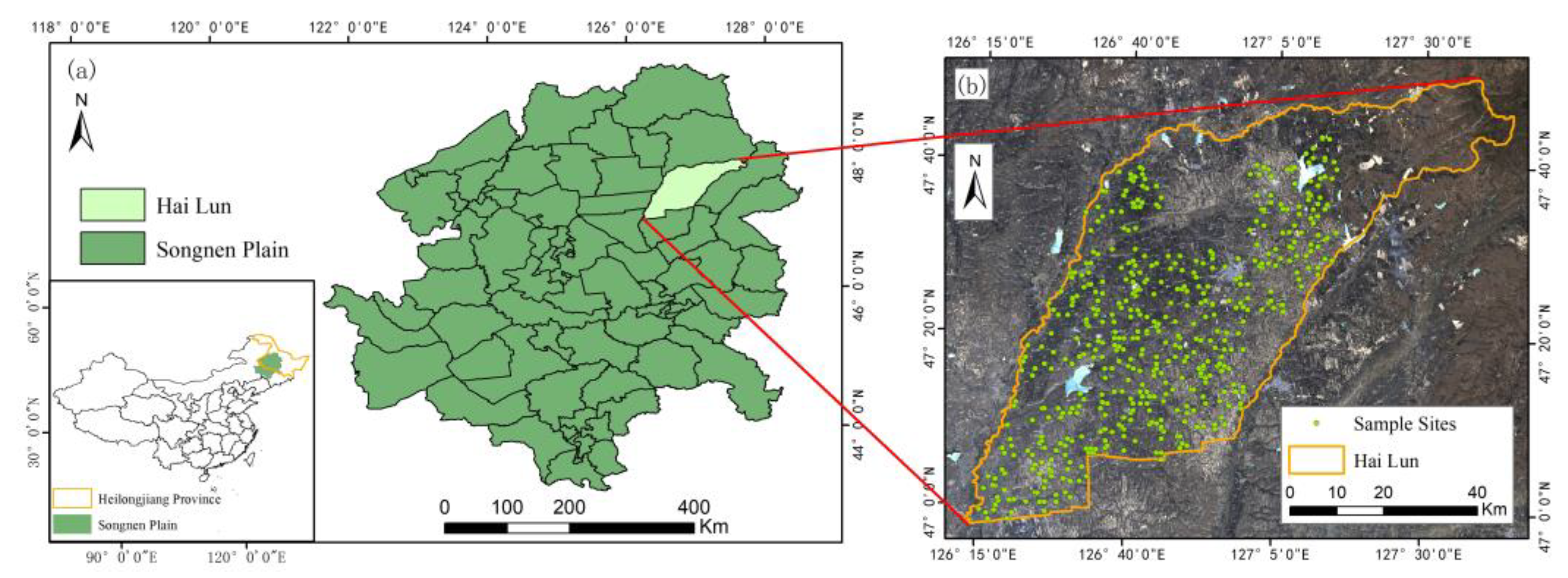
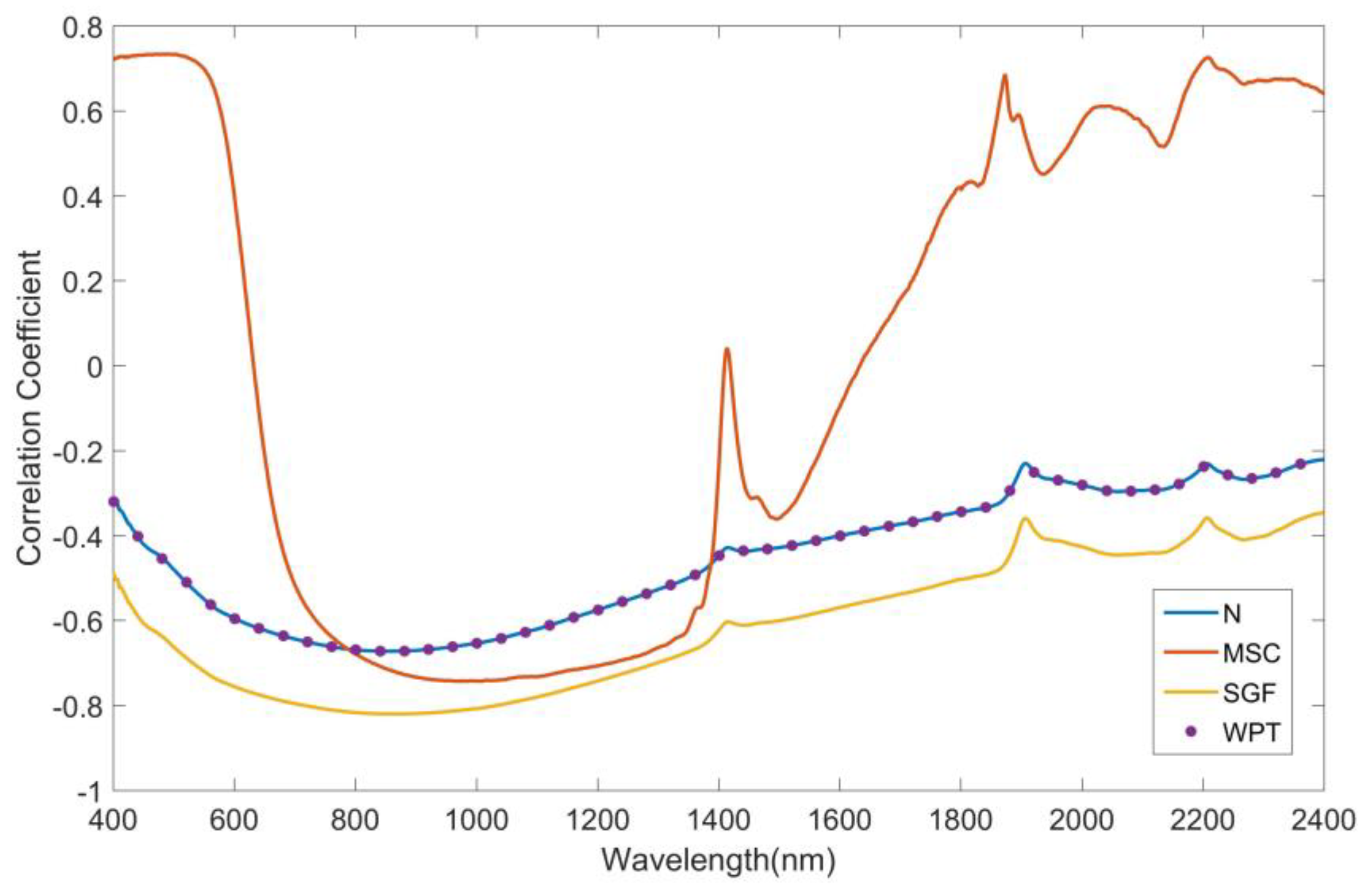
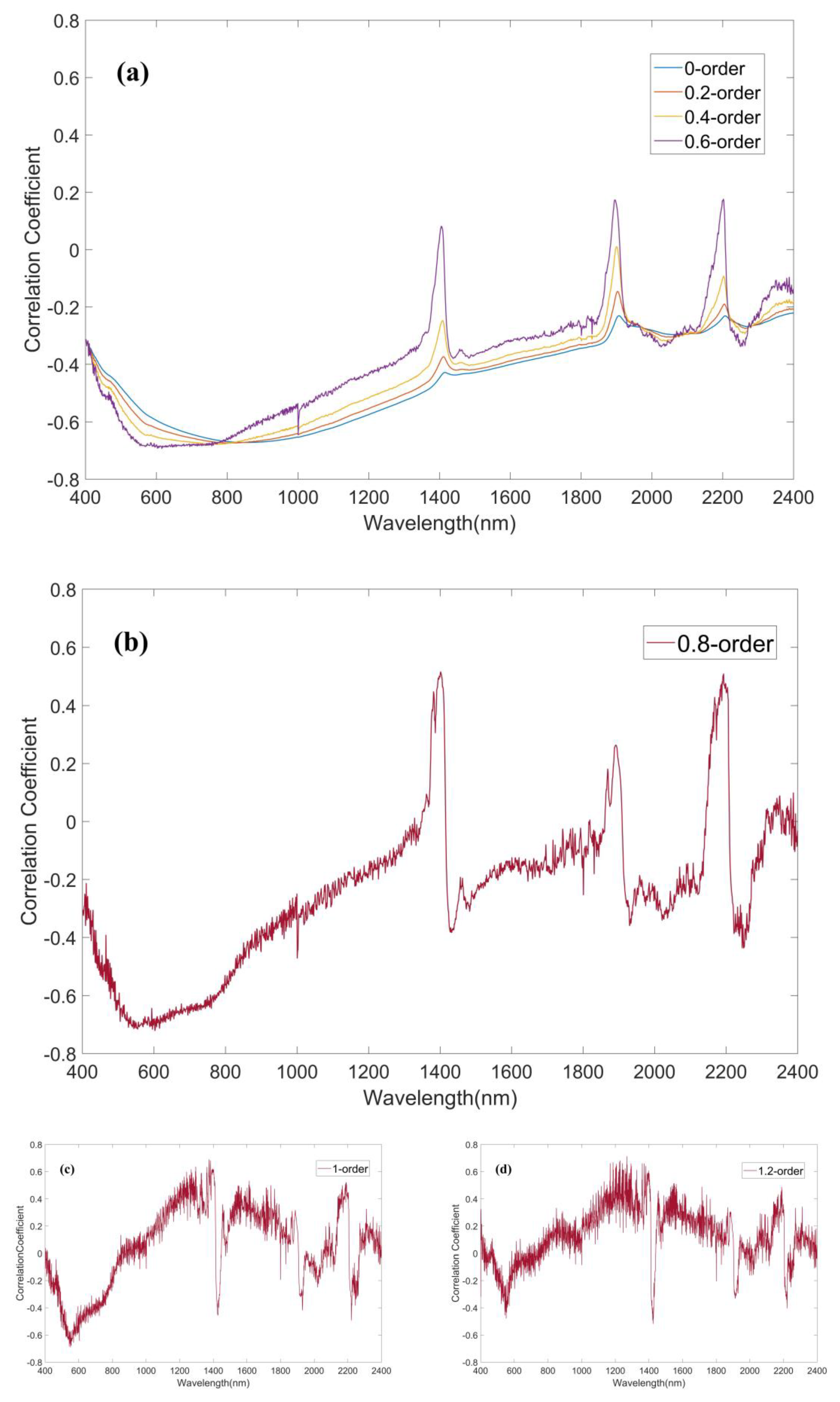
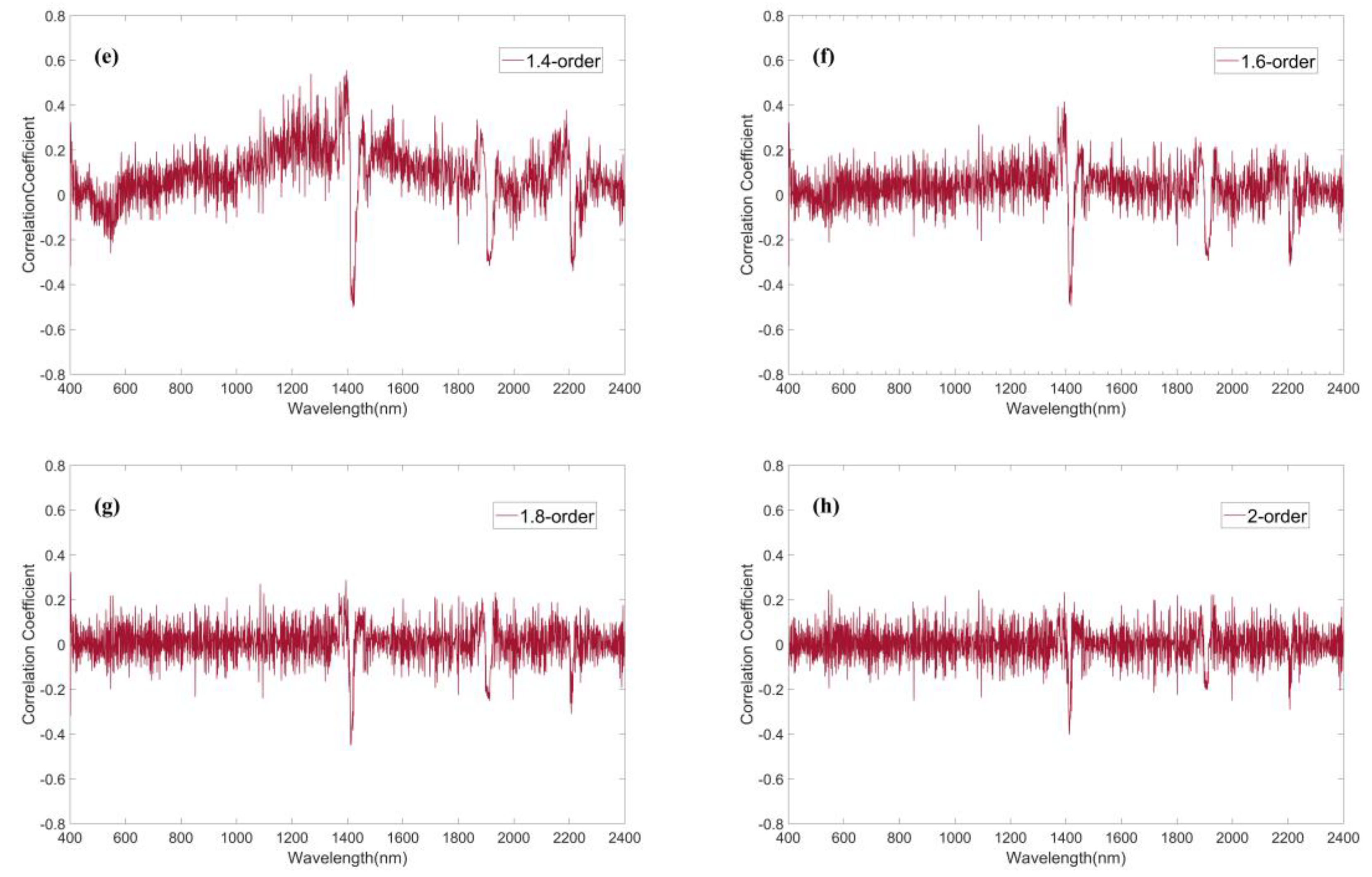
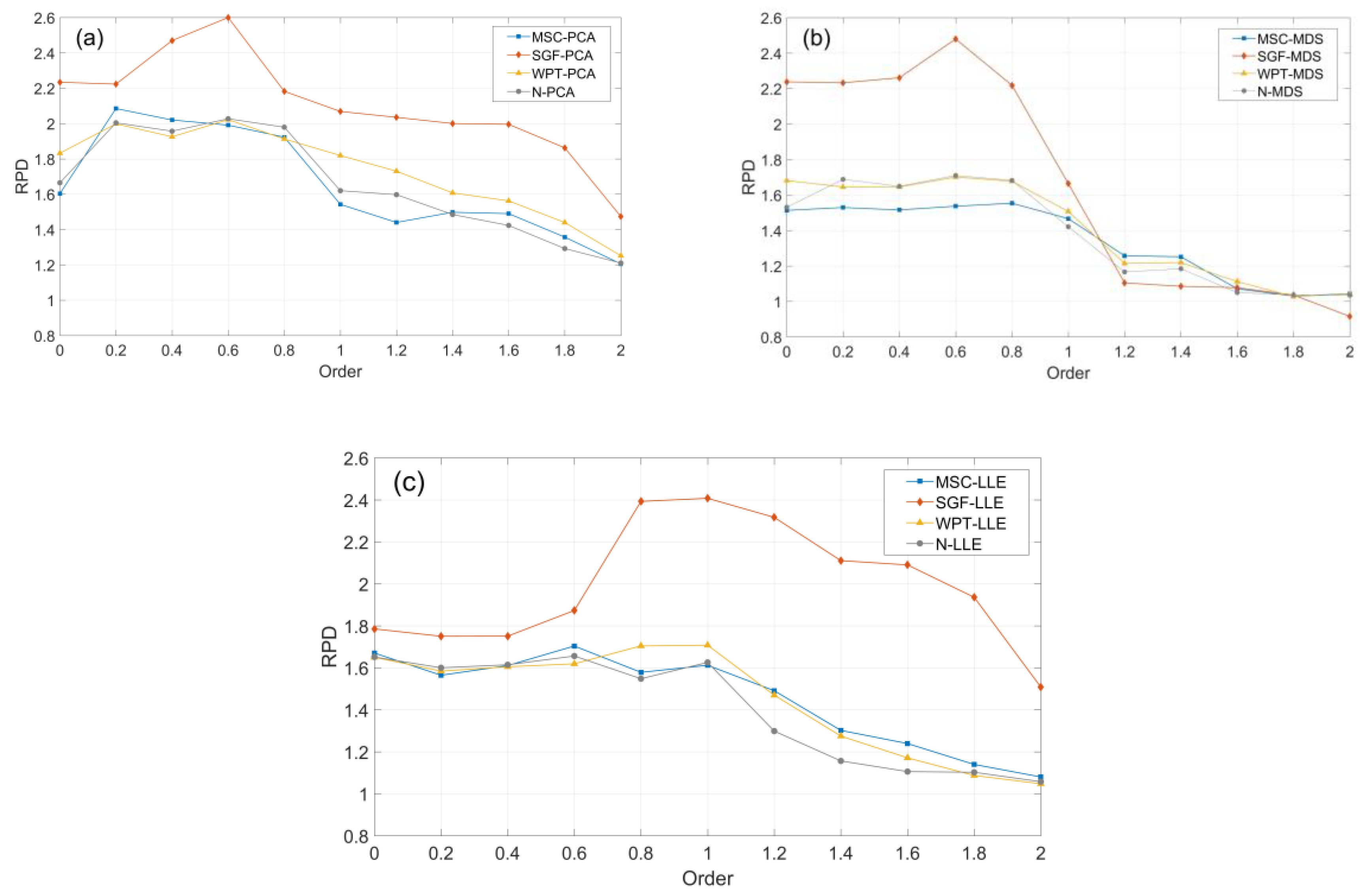
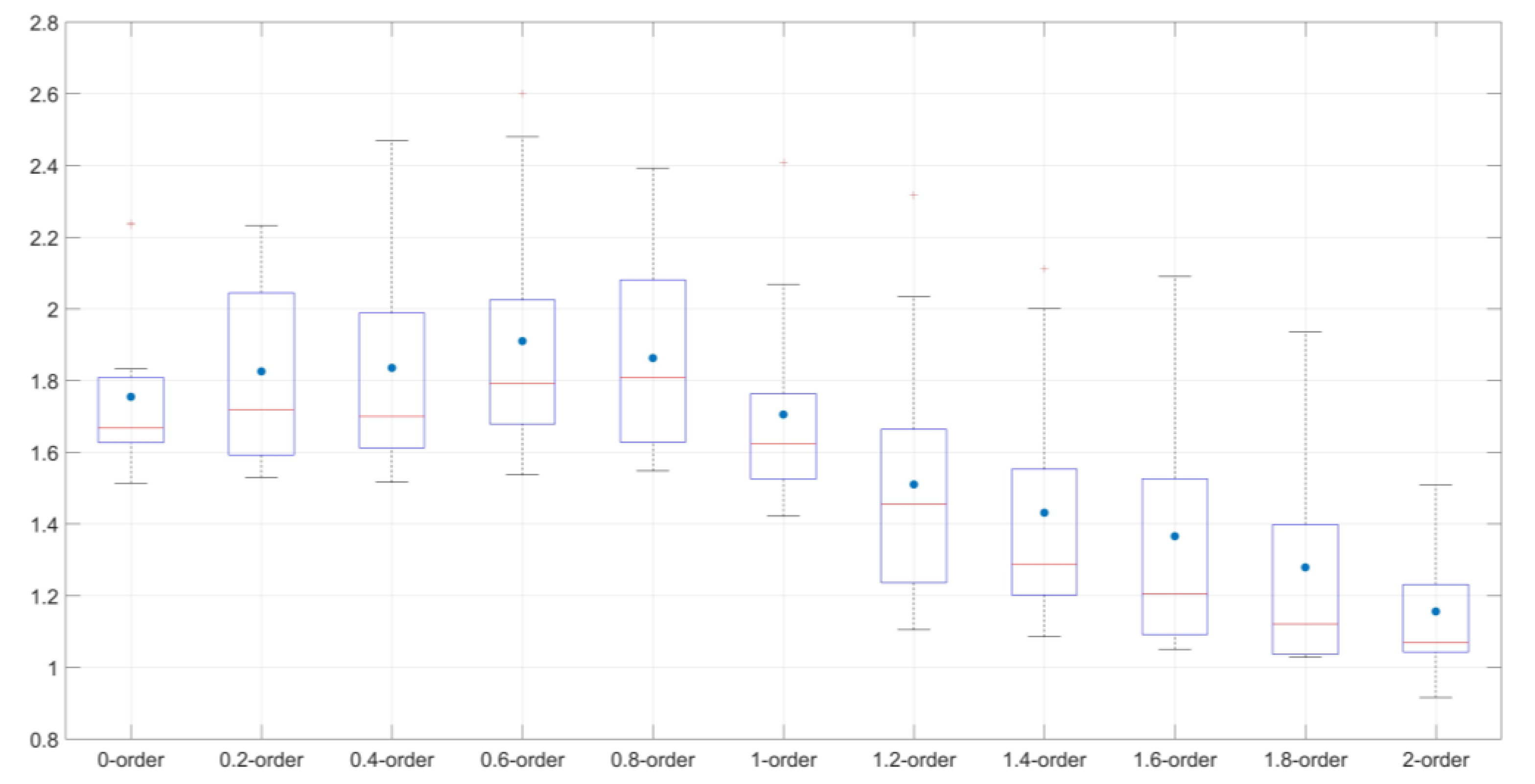
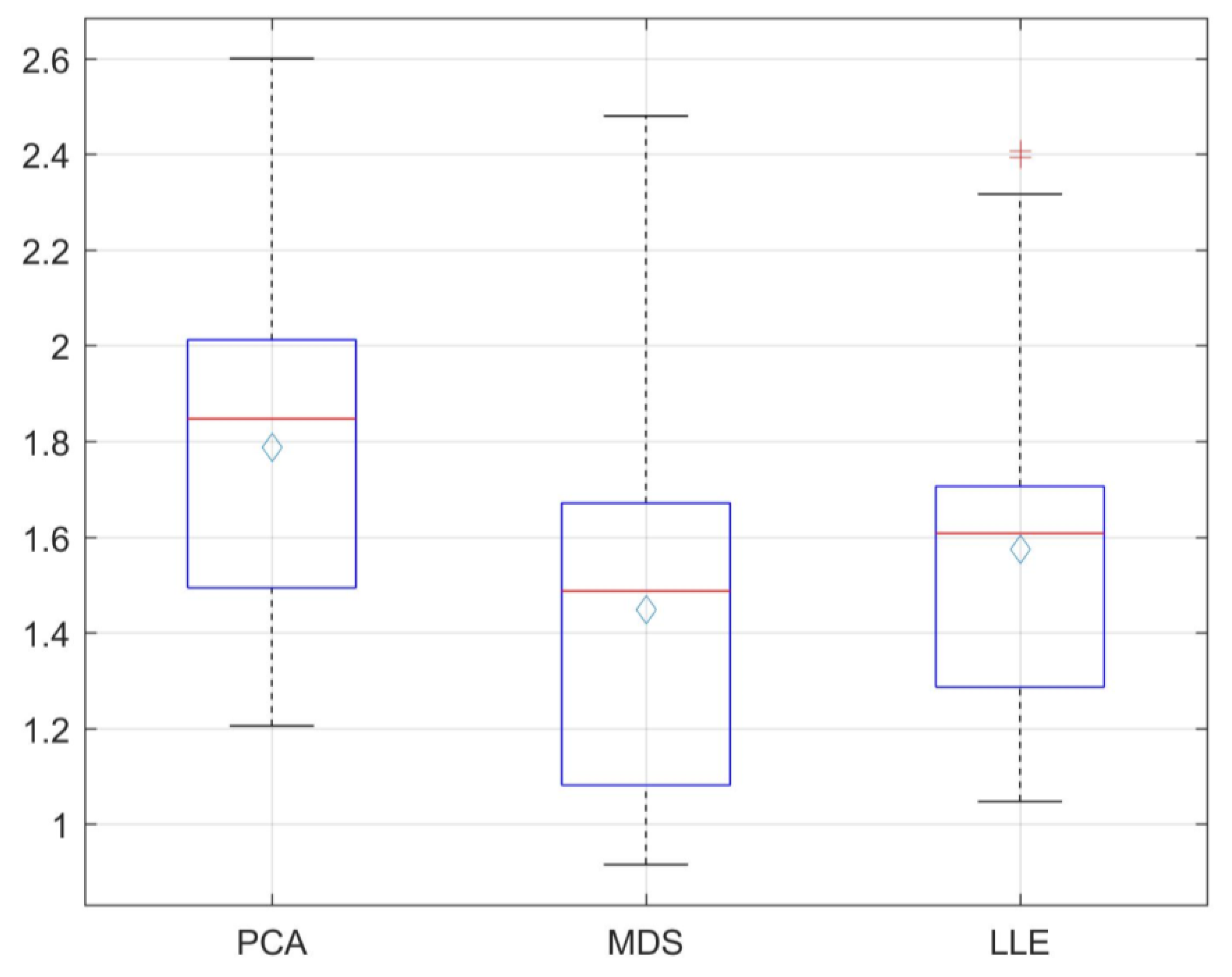
| Sample Set Type | Size of Sample Set | SOM (%) | ||||
|---|---|---|---|---|---|---|
| Max | Min | Mean | Range | SD * | ||
| Original Sample Set | 496 | 4.73 | 0.49 | 2.48 | 4.24 | 0.64 |
| Training Sample Set | 372 | 4.73 | 0.69 | 2.49 | 4.04 | 0.64 |
| Validation Sample Set | 124 | 4.45 | 0.49 | 2.47 | 3.96 | 0.64 |
| Methods | List |
|---|---|
| Denoising | N, SGF, WPT, MSC |
| Derivative | fractional derivatives, FD, SD |
| Dimensionality reduction | PCA, MDS, LLE |
| Dimensionality Reduction Methods | Denoising Methods | RMSE | RPD | |
|---|---|---|---|---|
| PCA | N | 0.65 | 0.39 | 1.66 |
| PCA | SGF | 0.80 | 0.29 | 2.23 |
| PCA | MSC | 0.61 | 0.40 | 1.60 |
| PCA | WPT | 0.72 | 0.35 | 1.83 |
| MDS | N | 0.57 | 0.42 | 1.53 |
| MDS | SGF | 0.80 | 0.29 | 2.24 |
| MDS | MSC | 0.56 | 0.42 | 1.51 |
| MDS | WPT | 0.65 | 0.38 | 1.68 |
| LLE | N | 0.63 | 0.39 | 1.65 |
| LLE | SGF | 0.74 | 0.36 | 1.78 |
| LLE | MSC | 0.64 | 0.38 | 1.67 |
| LLE | WPT | 0.63 | 0.39 | 1.65 |
| Source of Variation | Sum of the Squares | Degrees of Freedom | Mean Square | F-Value | p-Value | Fcritical |
|---|---|---|---|---|---|---|
| Fractional Derivatives | 0.45 | 11 | 0.04 | 4.90 | 3.12 × 10−6 | 1.87 |
| Dimensionality Reduction Methods | PCA | MDS | LLE |
|---|---|---|---|
| Number of Advantage Model | 31 | 2 | 11 |
| The Optimal Model | SGF-0.6 order-PCA | SGF-0.6 order-MDS | SGF-1 order-LLE |
| of The Optimal Model | 0.85 | 0.84 | 0.83 |
| RMSE of The Optimal Model | 0.25 | 0.26 | 0.27 |
| RPD of The Optimal Model | 2.60 | 2.48 | 2.41 |
Publisher’s Note: MDPI stays neutral with regard to jurisdictional claims in published maps and institutional affiliations. |
© 2020 by the authors. Licensee MDPI, Basel, Switzerland. This article is an open access article distributed under the terms and conditions of the Creative Commons Attribution (CC BY) license (http://creativecommons.org/licenses/by/4.0/).
Share and Cite
Xu, X.; Chen, S.; Xu, Z.; Yu, Y.; Zhang, S.; Dai, R. Exploring Appropriate Preprocessing Techniques for Hyperspectral Soil Organic Matter Content Estimation in Black Soil Area. Remote Sens. 2020, 12, 3765. https://doi.org/10.3390/rs12223765
Xu X, Chen S, Xu Z, Yu Y, Zhang S, Dai R. Exploring Appropriate Preprocessing Techniques for Hyperspectral Soil Organic Matter Content Estimation in Black Soil Area. Remote Sensing. 2020; 12(22):3765. https://doi.org/10.3390/rs12223765
Chicago/Turabian StyleXu, Xitong, Shengbo Chen, Zhengyuan Xu, Yan Yu, Sen Zhang, and Rui Dai. 2020. "Exploring Appropriate Preprocessing Techniques for Hyperspectral Soil Organic Matter Content Estimation in Black Soil Area" Remote Sensing 12, no. 22: 3765. https://doi.org/10.3390/rs12223765





